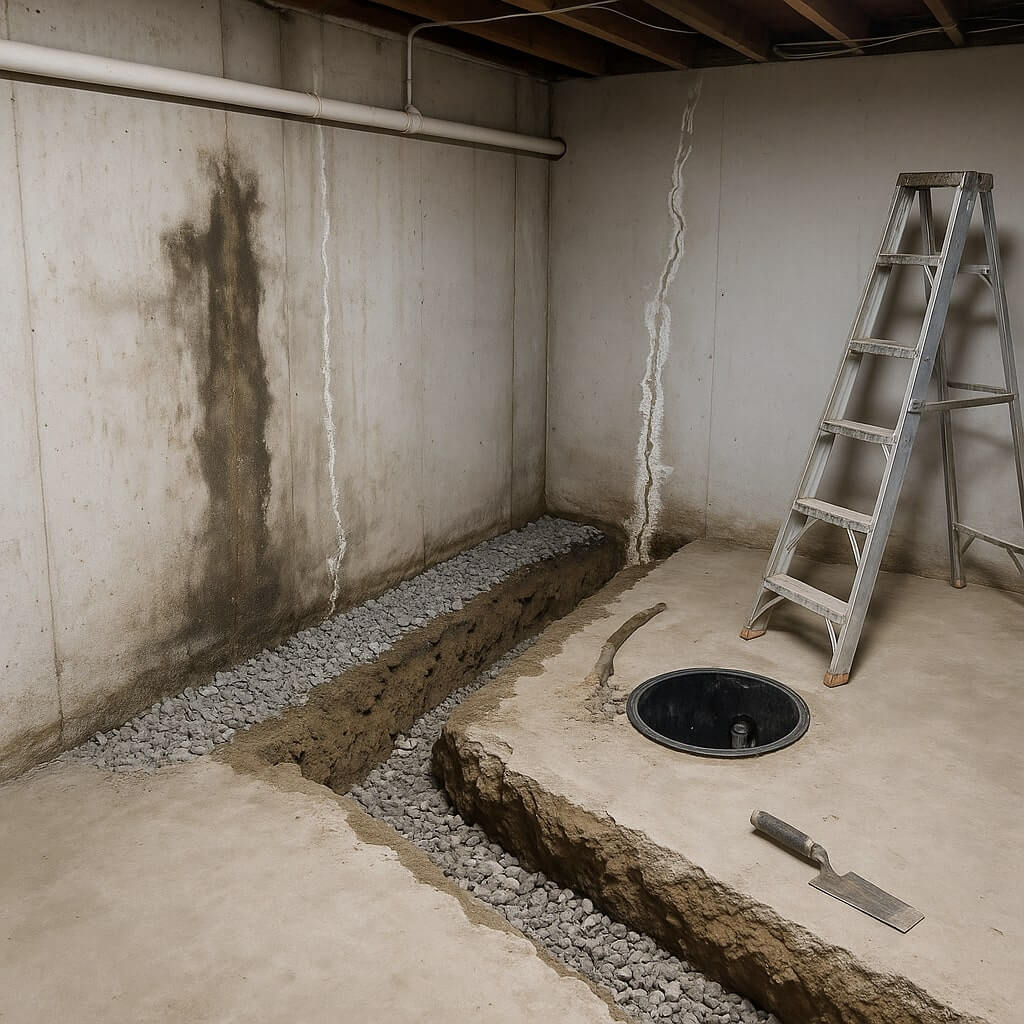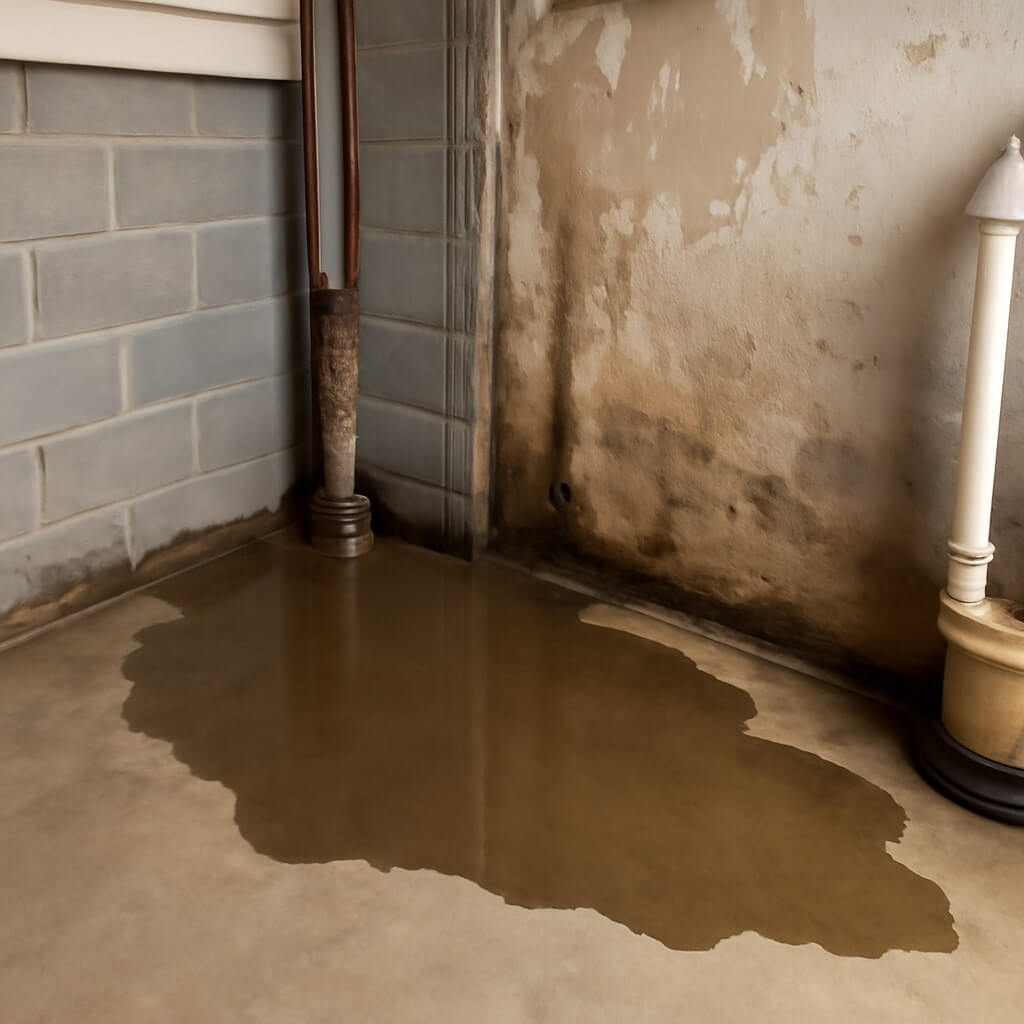When it comes to basement waterproofing in Oklahoma City, many homeowners make critical mistakes that can lead to significant issues down the line. From ignoring drainage systems to overlooking cracks in the foundation, these oversights can compromise your home’s integrity. Understanding these common pitfalls is essential for effective prevention. Let’s explore the top mistakes you need to avoid to guarantee your basement stays dry and secure.
Key Takeaways
- Neglecting regular gutter and downspout maintenance can lead to overflow and direct water toward your foundation, increasing the risk of basement flooding.
- Failing to seal visible cracks and gaps in foundations allows water to infiltrate basements unnoticed, causing significant damage over time.
- Relying solely on interior waterproofing methods without addressing exterior drainage systems can overlook critical moisture intrusion factors.
- Using low-quality waterproofing products may lead to inadequate protection and costly repairs due to water infiltration.
- Ignoring proper soil grading can cause water pooling around foundations, exacerbating waterproofing issues and increasing the risk of basement water damage.
Ignoring Proper Drainage Systems

When you ignore proper drainage systems, you’re setting yourself up for potential water damage in your basement. Understanding the different drainage system types is vital for effective waterproofing.
Interior drainage systems, like sump pumps, redirect water away from your foundation, while exterior systems, such as French drains, prevent water accumulation around your home. Implementing effective drainage solutions minimizes hydrostatic pressure and protects your basement.
Interior drainage systems, like sump pumps, work alongside exterior solutions like French drains to safeguard your basement from water damage.
Regularly assess and maintain these systems to guarantee they function correctly. By prioritizing proper drainage, you reduce the risk of costly repairs and extend the life of your basement structure.
Don’t overlook this essential aspect of waterproofing.
Failing to Inspect Gutters and Downspouts
How often do you check your gutters and downspouts? Regular gutter maintenance is vital for preventing basement water damage.
Clogged gutters can lead to overflow, which forces water toward your foundation. Make sure your downspouts are positioned correctly to direct water away from your home’s base. If they’re too close, they can contribute to moisture buildup in your basement.
Inspect these components at least twice a year and after heavy storms. Maintaining clear gutters and properly positioned downspouts can greatly reduce the risk of water intrusion in your basement, keeping your home safe and dry.
Don’t overlook this essential task!
Neglecting to Seal Cracks and Gaps
Even with well-maintained gutters and downspouts, water can still find its way into your basement through unnoticed cracks and gaps in your foundation.
Neglecting to seal these openings can lead to significant moisture issues. Here’s what you should know about crack sealing and gap filling:
- Inspect your foundation regularly for any visible cracks or gaps.
- Use high-quality sealants specifically designed for crack sealing.
- Guarantee proper surface preparation before applying any sealant or filler.
- Don’t forget to check around windows and doors, as these are common entry points.
Taking these steps helps protect your basement from water intrusion.
Using Inadequate Waterproofing Products
While it might be tempting to choose cheaper or generic waterproofing products for your basement, using inadequate materials can lead to costly repairs down the line. Prioritizing quality in your product selection is essential. Inferior materials often fail to provide the necessary protection against water infiltration, leading to mold, structural damage, and increased repair expenses.
| Product Type | Quality Option | Inadequate Option |
|---|---|---|
| Sealant | Polyurethane Sealant | Latex-Based Sealant |
| Membrane | EPDM Membrane | Thin Plastic Sheeting |
| Drainage System | French Drain System | Basic Gravel Layer |
| Sump Pump | Submersible Sump Pump | Manual Backup Pump |
| Waterproofing Paint | Waterproof Epoxy | Regular Interior Paint |
Overlooking Exterior Grading
When you neglect proper exterior grading, you greatly increase the risk of water pooling around your foundation. Effective grading techniques guarantee that water flows away from your home, protecting it from moisture damage.
Here are key considerations:
- Assess soil composition to determine drainage capabilities.
- Slope the ground away from the foundation at a minimum of 2% grade.
- Install drainage systems in areas with heavy rainfall.
- Regularly inspect and maintain grading to prevent erosion.
Disregarding the Importance of Sump Pumps
Proper exterior grading sets the foundation for effective water management, but even with the best grading practices, water intrusion can still occur. That’s where sump pumps come in.
Proper sump pump placement is vital; it should be located in the lowest part of your basement to effectively collect water. Neglecting to install a sump pump can lead to significant water damage.
Additionally, regular sump pump maintenance guarantees your system operates efficiently when needed most. Check for debris, test the pump regularly, and replace batteries if it’s a backup system.
Don’t disregard these steps; they’re essential for protecting your basement.
Skipping Regular Maintenance Checks
Many homeowners underestimate the importance of regular maintenance checks for their basement waterproofing systems. Skipping these checks can lead to significant issues down the line.
Establishing a maintenance schedule with regular inspections is vital to guarantee the longevity of your waterproofing efforts. Consider the following:
- Inspect for cracks or leaks in walls and floors.
- Check sump pump functionality and battery backup.
- Look for signs of mold or mildew growth.
- Assess drainage systems for blockages or damage.
Installing Windows Without Proper Sealing

Neglecting proper sealing during window installation can lead to serious water intrusion issues in your basement.
It’s essential to use effective sealing techniques to prevent moisture from seeping through gaps and cracks. Start by selecting high-quality caulk or foam specifically designed for window installations.
Guarantee all edges are thoroughly sealed, paying special attention to corners where leaks often occur. Additionally, check for any pre-existing damage to the window frame before installation.
By prioritizing proper sealing, you’ll protect your basement from water damage and maintain its structural integrity.
Don’t underestimate the importance of this step in your waterproofing efforts.
Improperly Ventilating the Basement
When you overlook adequate ventilation in your basement, you risk creating an environment ripe for moisture buildup and mold growth.
Proper basement airflow is essential for effective humidity control. Here are some common mistakes to avoid:
- Neglecting to install vents or fans
- Sealing windows and doors too tightly
- Ignoring condensation on walls and pipes
- Failing to use dehumidifiers when necessary
Relying Solely on Interior Waterproofing Solutions
Relying solely on interior waterproofing solutions can lead to significant problems if you don’t address the sources of water intrusion.
Understanding how water enters your basement is vital, as exterior solutions often play a key role in preventing moisture.
A thorough waterproofing approach that combines both interior and exterior methods is essential for long-term protection.
Understanding Water Sources
How can you effectively address water intrusion in your basement without overlooking the essential sources of moisture?
Relying solely on interior waterproofing solutions can lead to persistent issues if you don’t identify the water sources affecting your moisture levels.
Consider these key factors:
- Groundwater seepage from surrounding soil
- Poor drainage leading to surface water accumulation
- Plumbing leaks from interior fixtures
- Humidity levels from inadequate ventilation
Importance of Exterior Solutions
While interior waterproofing solutions can provide a temporary fix, they often fail to address the root causes of water intrusion, especially when exterior factors are at play.
Effective exterior drainage systems are vital for directing water away from your foundation. Without proper landscape grading, water can accumulate around your home, increasing hydrostatic pressure and leading to leaks.
Implementing exterior solutions not only reduces the risk of water damage but also enhances the longevity of your property. By focusing on both drainage and grading, you can create a thorough strategy that prevents water-related issues from arising in the first place.
Comprehensive Waterproofing Approach
When you depend solely on interior waterproofing solutions, you might overlook critical factors that contribute to water intrusion.
A thorough waterproofing approach combines both interior and exterior strategies for effective results. Relying only on indoor methods can lead to recurring issues.
Consider these integrated solutions:
- Proper drainage installation to redirect water away from your foundation
- Exterior waterproofing membranes that create a barrier against moisture
- Regular maintenance of gutters and downspouts for peak performance
- Soil grading adjustments to guarantee water flows away from the home
Implementing these extensive strategies will help protect your basement from water damage.
Conclusion
In Oklahoma City, avoiding common basement waterproofing mistakes is vital for protecting your home’s foundation. By ensuring proper drainage systems, maintaining gutters, sealing cracks, and using quality materials, you can greatly reduce the risk of water intrusion. Regular maintenance checks and proper ventilation further enhance your basement’s integrity. Don’t rely solely on interior solutions; a thorough approach is essential. By addressing these key areas, you’ll safeguard your basement against costly repairs and long-term damage.




